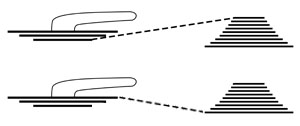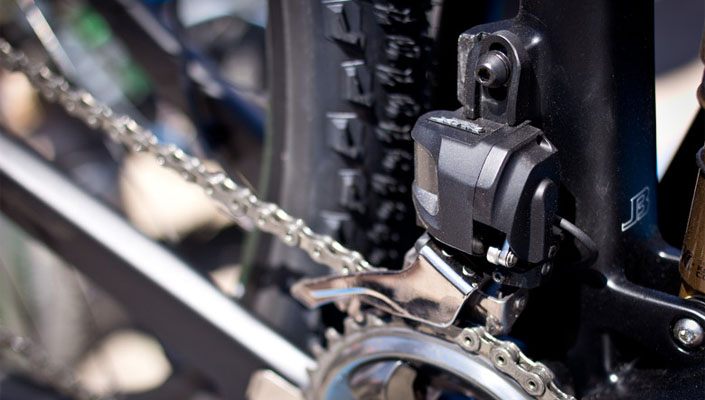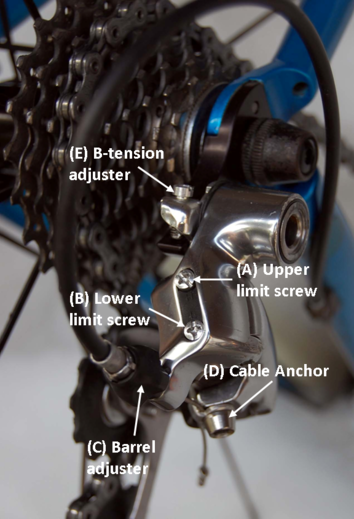Unless you’re a die-hard single speeder or have converted your bike to a 1x and have forgotten what it’s like to have more than one chainring, smooth and effective shifting between chainrings is a basic, but crucial, skill. Even with some pretty cool technology coming on the market to help make shifting easier than ever, now is a great time to make sure you’ve got your shifting under control.
Why do (some) bikes have gears?
Gears enable a cyclist to ride more comfortably over a variety of terrain. With gears, you're able to choose how your pedaling work - speed (cadence) and pressure (power) - is used to propel the bike forward.
It’s easy to focus on mastering how to use the gears at the back while leaving things pretty much alone at the front. For many people, the front gears are the go-to only when things point up or start to point down! By learning to change between the front chainrings you can add or take off a whole lot of gears in one quick move.
Front shifter and front derailleur trim

Typically the left shifter is setup to control the front derailleur so it shifts the chain between the chainrings. As you work down (or up) to the last few gears in the back cassette, have you ever heard a grinding/rubbing noise? In an otherwise well adjusted drivetrain, it's likely the chain rubbing on the front derailleur mechanism as the angle of the ‘chainline’ gets more diagonal – also known as cross-chaining.
If you'd like to be able to use the full range of your gears without that pesky rubbing noise, the trim function of many front shifters can make the bad noises go away.
NOTE:
Not all shifters have a trim function. For example, SRAM has introduced a front derailleur development, Yaw technology, to solve the chain rub issue and has eliminated trim function from its related shifters. Check the spec's of your bike's brand and model front shifter and derailleur to determine if it uses trim.
You may have heard the word trim used in connection with shifting, or you may have even done it accidentally while shifting, but never knew the name for it. Either way, “trimming” is an important skill to have when you access the gears in the extremes of your bike’s range.
The trim function is essentially a ‘microshift’ or 'half-shift' - it moves the front mech ever so slightly without moving the chain off the chainring like a full or regular shift. The silence gained from using trim is rewarding enough, but it's also useful in stealthily launching surprise uphill attacks on your riding mates.
DID YOU KNOW?
Even though the trim function can help take care of the noises, when the chain is at the inner and outer most extremes it isn’t kind on your bike's hardware. Chain and driveline parts wear faster and shift less reliably if constantly cross-geared.
Technology is improving shifting
All still seems like hard work? It’s ok, technology is here to save us! Now that you know about trimming, get ready to have your mind (and wallet) blown. Automatic trimming in electronic groupsets!
These are top of the range bits of kit from the big manufacturers such as Campagnolo EPS, SRAM eTap, and Shimano Di2. These electronic grouppos ‘sense’ when the chainline is getting too extreme and trim for you. I know, right?
The most advanced electronic groupset, Shimano’s Di2 for MTB, goes one step further and will actually automatically shift the chain between rings front and rear as it senses cross-gearing. Think automatic gearboxes for bikes! (You can, of course, turn this function off if you develop iRobot related concerns about whether or not your bike is subject to the Three Laws.)

So, technology is aiding to eradicate cross-gearing and chain rub, but even if you have a mechanical set up, there’s high chance that with a few gentle clicks you can experience quieter, better riding and sneak your way past your mates on that hill!

RELATED ARTICLE:
How to adjust your rear derailleur in 5 easy steps
Adjusting a rear derailleur is an important skill to master. There are few things more annoying than a clicking drivetrain; the sound of a chain that just can't decide which gear it's meant to be in.By following these simple steps... READ MORE

RELATED ARTICLE:
Mountain bike groupset comparison: Shimano vs. SRAM
The cycling world is saturated with products and brands for anything you could possibly ever want, but one of the more popular topics of discussion is 'which groupset do I choose' when it comes to your off-road ride. Mountain bike groupsets are divided into two major brands... READ MORE



